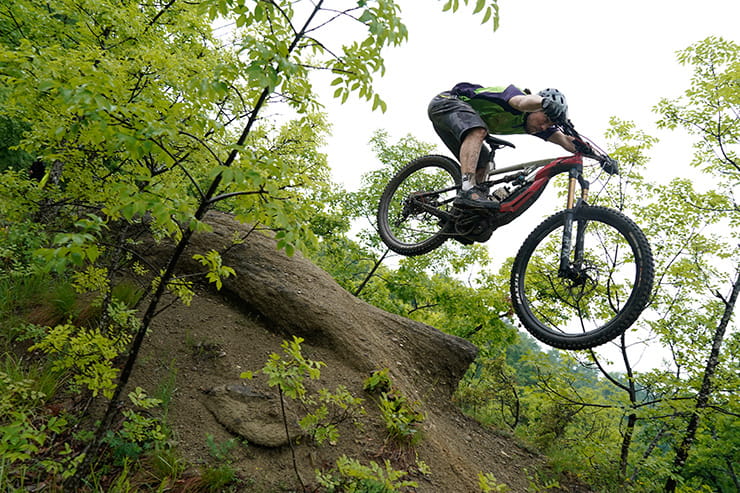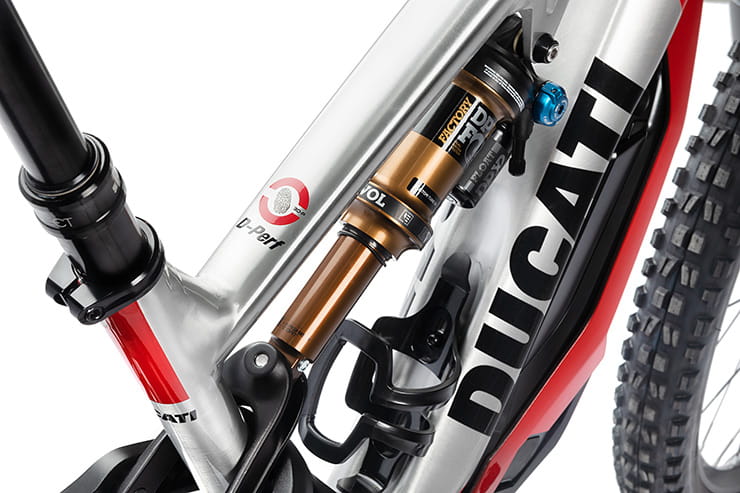OK, so we misled you a little there, Ducati hasn’t released an electric motorcycle yet, but they have launched an electric-assist bicycle. The MIG-RR is Ducati’s first step into the world of electric-powered vehicles; they did make electric razors back in the 1940s, but apparently not much of that technology passes over. This isn’t, however, Ducati’s first experience with bicycles; the company’s two-wheeled roots were founded in 1946 with a 1.5hp, 50cc auxiliary engine for fitting to bicycles at the time. Ducati CEO Claudio Domenicali compared the move into e-bikes to the decisions to branch out from sports bikes into bikes like the Multistrada and, later, the Scrambler. The MIG-RR is an electric-assist mountain bike, developed in partnership with Thok E-bikes – another Italian company, headed by Downhill mountain bike champion Stefano Migliorini, alongside MotoGP legend Livio Suppo.
What is an e-mtb?
E-bikes, or pedal assist bikes have been growing rapidly in popularity for several years now. The basic principle is that an electric motor provides additional pedaling force when the rider pedals, letting you ride further and faster for the same effort put in. Or ride the same distance as you would on a regular bicycle but with hardly any effort at all. It’s like having a set of pro-cyclist’s legs on loan for a few hours. This was a nice, if unexciting concept when applied to city bicycles and cruisers. But more recently the development of proper enduro bicycles with electronic assistance has exploded and now we have mountain bikes that can hammer down the roughest descents, then give you a helping hand to pedal back to the top.
2019 Ducati MIG-RR Price
The MIG-RR will set you back £5,500; steep if you aren’t used to paying more than two-hundred quid for a bike, but it is priced in the right ballpark for a high-spec electric assist mountain bike. The fact that Ducati has resisted the temptation to bung an over-inflated price tag on the MIG-RR backs up their commitment to the e-bike market. Plus, within ten minutes of riding one, you’ll be amazed at how creative you get justifying the purchase to yourself, your colleagues, your wife and the surgeon you get to remove your kidney. The MIG-RR is available to test ride and order in selected Ducati dealerships now.
Power and torque
The MIG-RR has a 250W Shimano motor that applies power through the chain to the rear wheel in proportion to the force you put in through the pedals. In Eco mode, the assistance is light, helping you maintain speed on flat ground and gentle slopes. Trail mode makes you feel like you have woken up with incredibly strong legs, giving you the power to sprint through soft mud and up loose, rocky climbs. For getting up even more technical climbs, super steep stuff or rock steps, Boost mode gives another step up in extra power, helping you charge over frankly impossible terrain. The Trail and Boost modes let you ride through, up and over things that you simply wouldn’t be able to on a regular mountain bike, unless you have the skills of Danny MacAskill.
Gearbox
To keep the MIG-RR flexible and to help battery life, it comes with an 11-speed setup from Shimano. Compared to a regular bicycle, you have to be a little smoother when shifting, as if you’re hard on the pedals between gears, the motor adds to that force and can make for harsh gearshifts. That said, this setup is still smoother than other e-mtbs I have ridden.
2019 Ducati MIG-RR Economy
In three hours of wet, treacherous trails, repeatedly climbing up and blasting back down the steep hillside I managed to use three of the five bars of battery life. That is riding predominantly in the middle power setting, Trail mode, using Boost for the steeper climbs and Eco on some of the flatter sections.
Handling, suspension, chassis and weight
The low-slung battery makes the bike feel lighter than it is, letting you throw it around on the trail much like a regular bike. You notice the extra weight occasionally when hopping over gullies or lifting the bike to turn it around for another run at that last bit of trail. Ducati and Thok worked hard on the chassis to make a bike that is stable through rough sections, yet nimble in the turns. The solution they arrived at was a larger, 29” front wheel and a smaller 27.5” wheel in the rear. The result is a bike that gives less experienced riders the confidence to tackle more and lets experienced riders throw the bike into sharp turns and switchbacks with ease.
2019 Ducati MIG-RR Brakes
Shimano Saint four-pot brakes do a fantastic job of hauling the MIG-RR back to a stop, while providing plenty of feel when tip-toeing down steep chutes. They were noticeably squeaky in the wet conditions, but then so were all the sun-blessed European riders…
2019 Ducati MIG-RR verdict
The MIG-RR does exactly what an e-mountain bike is supposed to do – puts a huge smile on the face of every rider who sits on it, regardless of age or ability. The confidence inspiring chassis lets you get the most out of the electronic assistance, urging you to tackle harder and harder terrain. If you haven’t tried one yet, get yourself into a Ducati dealership and go for a spin on the new MIG-RR – mountain biking just got a whole lot more fun. When pressed for an indication of whether this was leading to a full electric motorbike, Ducati’s answer was no, but of course electric technology is something they are looking into.
Three things I loved about the Ducati MIG-RR (2019)…
- Ability to make every ride fun for every kind of rider.
- Lightweight feel and playful handling
- Going flat out up rocky climbs in Boost mode is awesome!
Three things that I didn’t…
- On/off switch is tucked under the frame tube – would be easier access if you could use the handlebar switch to power up
- Squeaky brakes (although this is a common theme with bicycle brakes)
- Having to wear my wet shoes on the plane home, although I’m not sure I can blame the bike for that.
Ducati MIG-RR Review (2019) spec
|
New price
|
From £5,500
|
|
Capacity
|
n/a
|
|
Bore x Stroke
|
n/a
|
|
Engine layout
|
Crank-mounted electric motor
|
|
Engine details
|
Shimano Steps E8000
|
|
Power
|
250 Watt
|
|
Torque
|
70 Nm
|
|
Top speed
|
E-assist is limited to 25km/h
|
|
Transmission
|
Shimano Deore XT 11-speed, chain final drive
|
|
Average fuel consumption
|
120W/h average on test.
|
|
Tank size
|
504Wh
|
|
Max range to empty (theoretical)
|
n/a
|
|
Reserve capacity
|
Rider dependent
|
|
Rider aids
|
Race Face Turbine Dropper post
|
|
Frame
|
Alloy hydro-formed frame, Forged and CNC components
|
|
Front suspension
|
FOX 36 Float 29 Factory, 170mm travel
|
|
Front suspension adjustment
|
Air spring pressure, rebound and compression damping
|
|
Rear suspension
|
FOX DPX2 Factory, 160mm travel
|
|
Rear suspension adjustment
|
Air spring pressure, rebound and compression damping
|
|
Front brake
|
Shimano Saint, four piston caliper, floating 203mm disc
|
|
Rear brake
|
Shimano Saint, four piston caliper, floating 203mm disc
|
|
Front tyre
|
Maxxis Minion DHF 29x2.6
|
|
Rear tyre
|
Maxxis Minion DHR 27.5x2.8
|
|
Rake
|
65.7°
|
|
Wheelbase
|
1197mm (Medium frame, as tested)
|
|
Ground clearance
|
358mm to bottom bracket centre
|
|
Seat height
|
Variable with hydraulic seat post
|
|
Kerb weight
|
22.5kg (Medium frame, no pedals)
|
|
Warranty
|
|
|
Website
|
www.Ducati.com
|
To learn more about what the spec sheet means, click here for our glossary
Images: Milagro











